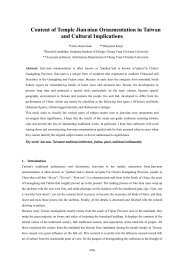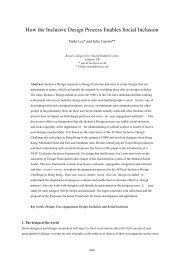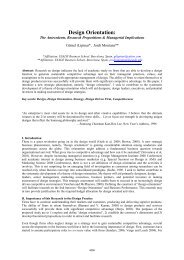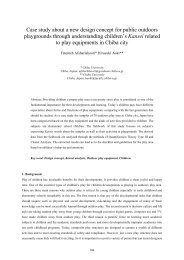Patterns of the Incremental and Radical Innovation of Design ...
Patterns of the Incremental and Radical Innovation of Design ...
Patterns of the Incremental and Radical Innovation of Design ...
You also want an ePaper? Increase the reach of your titles
YUMPU automatically turns print PDFs into web optimized ePapers that Google loves.
However, According to <strong>the</strong> research finding, innovation activities in each phase vary from one company to<br />
ano<strong>the</strong>r, which depend on company’s execution preference <strong>and</strong> project situation. For most companies, radical<br />
innovation shares <strong>the</strong> same process with incremental innovation, but <strong>the</strong> contents <strong>of</strong> activities <strong>and</strong> emphasis are<br />
different; <strong>the</strong> sequence <strong>of</strong> sub-steps in radical innovation is fuzzy, especially in <strong>the</strong> initial phase.<br />
3.4 Levels <strong>of</strong> design knowledge in <strong>the</strong> product innovation<br />
Table 2 <strong>and</strong> Table 3 demonstrates, within both incremental <strong>and</strong> radical innovation, design plays an important role<br />
<strong>and</strong> has various impacts on all <strong>the</strong> phases. Various design activities required a lot <strong>of</strong> knowledge to execute design<br />
tasks, which can be categorised into four levels: basic operations & skills, tacit knowledge, design strategic<br />
knowledge <strong>and</strong> visionary capabilities. Based on Hytőnen et al’s [10] model, a new level <strong>of</strong> capability has been<br />
added, i.e. visionary capability.<br />
Table 2 Six companies’ design impacts in incremental <strong>and</strong> radical innovation<br />
<strong>Design</strong> impact in incremental innovation <strong>Design</strong> impact in radical innovation<br />
COM1 Concept generation<br />
Concept generation<br />
Styling<br />
Styling<br />
Usability<br />
UI<br />
<strong>Design</strong> coordinating<br />
Coordination<br />
COM2 Product styling design<br />
Product styling design<br />
Prototype<br />
Prototype<br />
User research<br />
More in-depth user research<br />
Project presentation<br />
Presentation<br />
Coordination with o<strong>the</strong>r people<br />
High involvement <strong>of</strong> coordination<br />
COM3 Research<br />
Research<br />
Usability<br />
Usability<br />
UI<br />
User experience<br />
Packaging<br />
<strong>Design</strong> execution<br />
COM4 Concept generation<br />
Concept generation<br />
Visualization<br />
Visualization<br />
<strong>Design</strong> execution<br />
<strong>Design</strong> execution<br />
COM5 Plan <strong>the</strong> product portfolio <strong>of</strong> <strong>the</strong> company<br />
Identify potential areas in <strong>the</strong> research stage<br />
Explore <strong>the</strong> potential customer needs<br />
COM6 Research about <strong>the</strong> form establishment Research about <strong>the</strong> form establishment<br />
PI (product identity) design<br />
PI (product identity) design<br />
Prototype<br />
Prototype<br />
Gate keeper in <strong>the</strong> production phase Gate keeper in <strong>the</strong> production phase<br />
Basic operations & skills: <strong>the</strong>se are <strong>the</strong> basic requirements for design execution. The main operations <strong>and</strong> skills<br />
identified in <strong>the</strong> case studies are product styling, aes<strong>the</strong>tics, prototyping, sketching, usability <strong>and</strong> user research;<br />
sometimes UI (user interface) <strong>and</strong> packaging also need designers to accomplish. Besides, a lot <strong>of</strong> o<strong>the</strong>r design<br />
related knowledge, such as modelling technologies, material finishing, mechanical design, supply chain,<br />
business <strong>and</strong> market knowledge is required to be understood by designers.<br />
Tacit knowledge: this study also discovered tacit knowledge related to personal features such as coordination<br />
capabilities, design presentation skills <strong>and</strong> negotiation abilities is important in <strong>the</strong> innovation process. Many<br />
subjects mentioned that coordination is an essential design impact. <strong>Design</strong> or innovation requires this tacit<br />
knowledge for better <strong>and</strong> smoo<strong>the</strong>r execution.<br />
300







